Zixin Wen
Scaling Latent Reasoning via Looped Language Models
Oct 29, 2025Abstract:Modern LLMs are trained to "think" primarily via explicit text generation, such as chain-of-thought (CoT), which defers reasoning to post-training and under-leverages pre-training data. We present and open-source Ouro, named after the recursive Ouroboros, a family of pre-trained Looped Language Models (LoopLM) that instead build reasoning into the pre-training phase through (i) iterative computation in latent space, (ii) an entropy-regularized objective for learned depth allocation, and (iii) scaling to 7.7T tokens. Ouro 1.4B and 2.6B models enjoy superior performance that match the results of up to 12B SOTA LLMs across a wide range of benchmarks. Through controlled experiments, we show this advantage stems not from increased knowledge capacity, but from superior knowledge manipulation capabilities. We also show that LoopLM yields reasoning traces more aligned with final outputs than explicit CoT. We hope our results show the potential of LoopLM as a novel scaling direction in the reasoning era. Our model could be found in: http://ouro-llm.github.io.
Faster WIND: Accelerating Iterative Best-of-$N$ Distillation for LLM Alignment
Oct 28, 2024


Abstract:Recent advances in aligning large language models with human preferences have corroborated the growing importance of best-of-N distillation (BOND). However, the iterative BOND algorithm is prohibitively expensive in practice due to the sample and computation inefficiency. This paper addresses the problem by revealing a unified game-theoretic connection between iterative BOND and self-play alignment, which unifies seemingly disparate algorithmic paradigms. Based on the connection, we establish a novel framework, WIN rate Dominance (WIND), with a series of efficient algorithms for regularized win rate dominance optimization that approximates iterative BOND in the parameter space. We provides provable sample efficiency guarantee for one of the WIND variant with the square loss objective. The experimental results confirm that our algorithm not only accelerates the computation, but also achieves superior sample efficiency compared to existing methods.
Transformers Provably Learn Feature-Position Correlations in Masked Image Modeling
Mar 04, 2024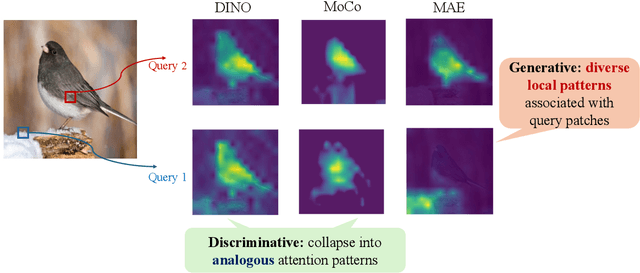

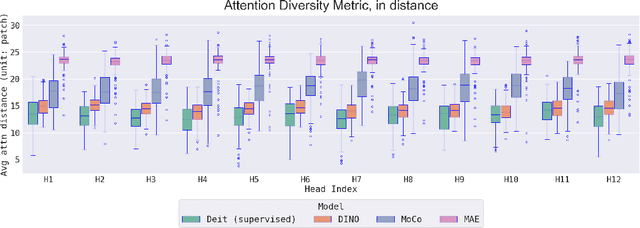

Abstract:Masked image modeling (MIM), which predicts randomly masked patches from unmasked ones, has emerged as a promising approach in self-supervised vision pretraining. However, the theoretical understanding of MIM is rather limited, especially with the foundational architecture of transformers. In this paper, to the best of our knowledge, we provide the first end-to-end theory of learning one-layer transformers with softmax attention in MIM self-supervised pretraining. On the conceptual side, we posit a theoretical mechanism of how transformers, pretrained with MIM, produce empirically observed local and diverse attention patterns on data distributions with spatial structures that highlight feature-position correlations. On the technical side, our end-to-end analysis of the training dynamics of softmax-based transformers accommodates both input and position embeddings simultaneously, which is developed based on a novel approach to track the interplay between the attention of feature-position and position-wise correlations.
Revisiting Disentanglement in Downstream Tasks: A Study on Its Necessity for Abstract Visual Reasoning
Mar 01, 2024



Abstract:In representation learning, a disentangled representation is highly desirable as it encodes generative factors of data in a separable and compact pattern. Researchers have advocated leveraging disentangled representations to complete downstream tasks with encouraging empirical evidence. This paper further investigates the necessity of disentangled representation in downstream applications. Specifically, we show that dimension-wise disentangled representations are unnecessary on a fundamental downstream task, abstract visual reasoning. We provide extensive empirical evidence against the necessity of disentanglement, covering multiple datasets, representation learning methods, and downstream network architectures. Furthermore, our findings suggest that the informativeness of representations is a better indicator of downstream performance than disentanglement. Finally, the positive correlation between informativeness and disentanglement explains the claimed usefulness of disentangled representations in previous works. The source code is available at https://github.com/Richard-coder-Nai/disentanglement-lib-necessity.git.
What Matters In The Structured Pruning of Generative Language Models?
Feb 07, 2023
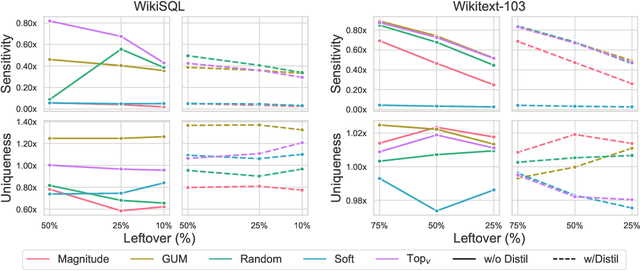

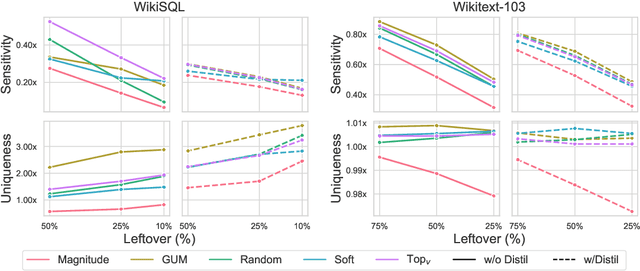
Abstract:Auto-regressive large language models such as GPT-3 require enormous computational resources to use. Traditionally, structured pruning methods are employed to reduce resource usage. However, their application to and efficacy for generative language models is heavily under-explored. In this paper we conduct an comprehensive evaluation of common structured pruning methods, including magnitude, random, and movement pruning on the feed-forward layers in GPT-type models. Unexpectedly, random pruning results in performance that is comparable to the best established methods, across multiple natural language generation tasks. To understand these results, we provide a framework for measuring neuron-level redundancy of models pruned by different methods, and discover that established structured pruning methods do not take into account the distinctiveness of neurons, leaving behind excess redundancies. In view of this, we introduce Globally Unique Movement (GUM) to improve the uniqueness of neurons in pruned models. We then discuss the effects of our techniques on different redundancy metrics to explain the improved performance.
The Mechanism of Prediction Head in Non-contrastive Self-supervised Learning
May 14, 2022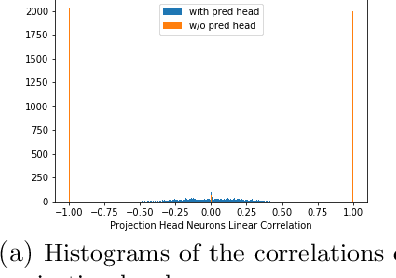
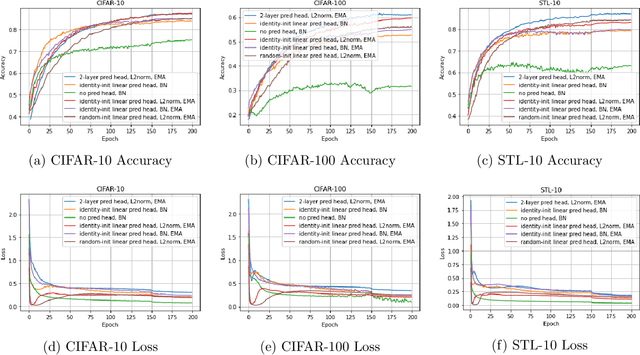
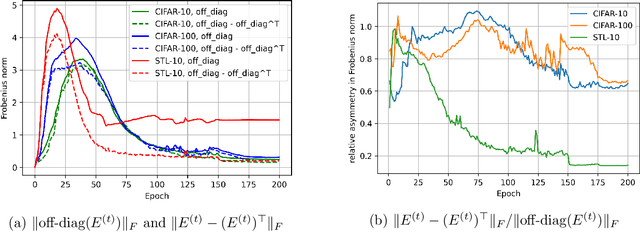

Abstract:Recently the surprising discovery of the Bootstrap Your Own Latent (BYOL) method by Grill et al. shows the negative term in contrastive loss can be removed if we add the so-called prediction head to the network. This initiated the research of non-contrastive self-supervised learning. It is mysterious why even when there exist trivial collapsed global optimal solutions, neural networks trained by (stochastic) gradient descent can still learn competitive representations. This phenomenon is a typical example of implicit bias in deep learning and remains little understood. In this work, we present our empirical and theoretical discoveries on non-contrastive self-supervised learning. Empirically, we find that when the prediction head is initialized as an identity matrix with only its off-diagonal entries being trainable, the network can learn competitive representations even though the trivial optima still exist in the training objective. Theoretically, we present a framework to understand the behavior of the trainable, but identity-initialized prediction head. Under a simple setting, we characterized the substitution effect and acceleration effect of the prediction head. The substitution effect happens when learning the stronger features in some neurons can substitute for learning these features in other neurons through updating the prediction head. And the acceleration effect happens when the substituted features can accelerate the learning of other weaker features to prevent them from being ignored. These two effects enable the neural networks to learn all the features rather than focus only on learning the stronger features, which is likely the cause of the dimensional collapse phenomenon. To the best of our knowledge, this is also the first end-to-end optimization guarantee for non-contrastive methods using nonlinear neural networks with a trainable prediction head and normalization.
Improving Multi-Modal Learning with Uni-Modal Teachers
Jun 21, 2021
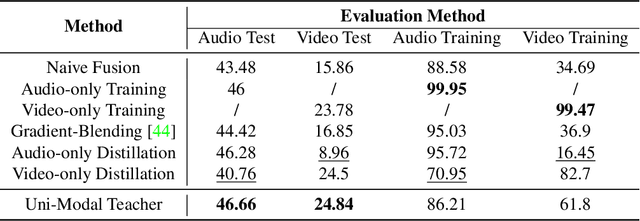
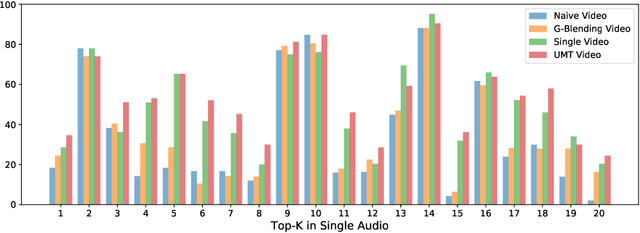

Abstract:Learning multi-modal representations is an essential step towards real-world robotic applications, and various multi-modal fusion models have been developed for this purpose. However, we observe that existing models, whose objectives are mostly based on joint training, often suffer from learning inferior representations of each modality. We name this problem Modality Failure, and hypothesize that the imbalance of modalities and the implicit bias of common objectives in fusion method prevent encoders of each modality from sufficient feature learning. To this end, we propose a new multi-modal learning method, Uni-Modal Teacher, which combines the fusion objective and uni-modal distillation to tackle the modality failure problem. We show that our method not only drastically improves the representation of each modality, but also improves the overall multi-modal task performance. Our method can be effectively generalized to most multi-modal fusion approaches. We achieve more than 3% improvement on the VGGSound audio-visual classification task, as well as improving performance on the NYU depth V2 RGB-D image segmentation task.
Toward Understanding the Feature Learning Process of Self-supervised Contrastive Learning
Jun 12, 2021
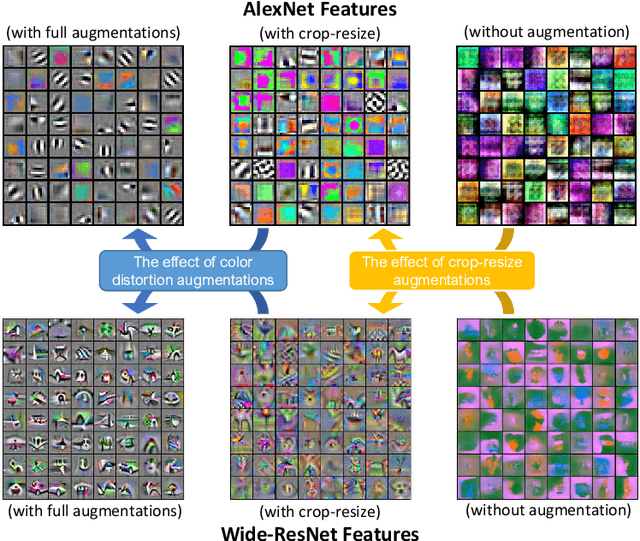
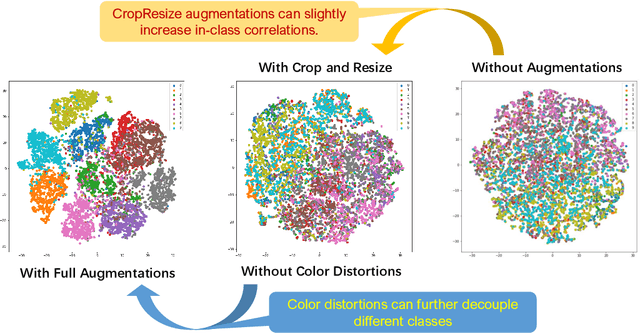
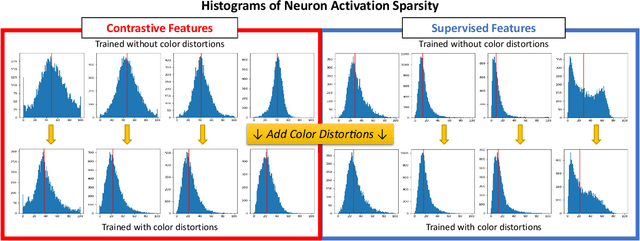
Abstract:How can neural networks trained by contrastive learning extract features from the unlabeled data? Why does contrastive learning usually need much stronger data augmentations than supervised learning to ensure good representations? These questions involve both the optimization and statistical aspects of deep learning, but can hardly be answered by analyzing supervised learning, where the target functions are the highest pursuit. Indeed, in self-supervised learning, it is inevitable to relate to the optimization/generalization of neural networks to how they can encode the latent structures in the data, which we refer to as the feature learning process. In this work, we formally study how contrastive learning learns the feature representations for neural networks by analyzing its feature learning process. We consider the case where our data are comprised of two types of features: the more semantically aligned sparse features which we want to learn from, and the other dense features we want to avoid. Theoretically, we prove that contrastive learning using $\mathbf{ReLU}$ networks provably learns the desired sparse features if proper augmentations are adopted. We present an underlying principle called $\textbf{feature decoupling}$ to explain the effects of augmentations, where we theoretically characterize how augmentations can reduce the correlations of dense features between positive samples while keeping the correlations of sparse features intact, thereby forcing the neural networks to learn from the self-supervision of sparse features. Empirically, we verified that the feature decoupling principle matches the underlying mechanism of contrastive learning in practice.
Convergence of End-to-End Training in Deep Unsupervised Contrasitive Learning
Feb 21, 2020Abstract:Unsupervised contrastive learning has gained increasing attention in the latest research and has proven to be a powerful method for learning representations from unlabeled data. However, little theoretical analysis was known for this framework. In this paper, we study the optimization of deep unsupervised contrastive learning. We prove that, by applying end-to-end training that simultaneously updates two deep over-parameterized neural networks, one can find an approximate stationary solution for the non-convex contrastive loss. This result is inherently different from the existing over-parameterized analysis in the supervised setting because, in contrast to learning a specific target function, unsupervised contrastive learning tries to encode the unlabeled data distribution into the neural networks, which generally has no optimal solution. Our analysis provides theoretical insights into the practical success of these unsupervised pretraining methods.
 Add to Chrome
Add to Chrome Add to Firefox
Add to Firefox Add to Edge
Add to Edge